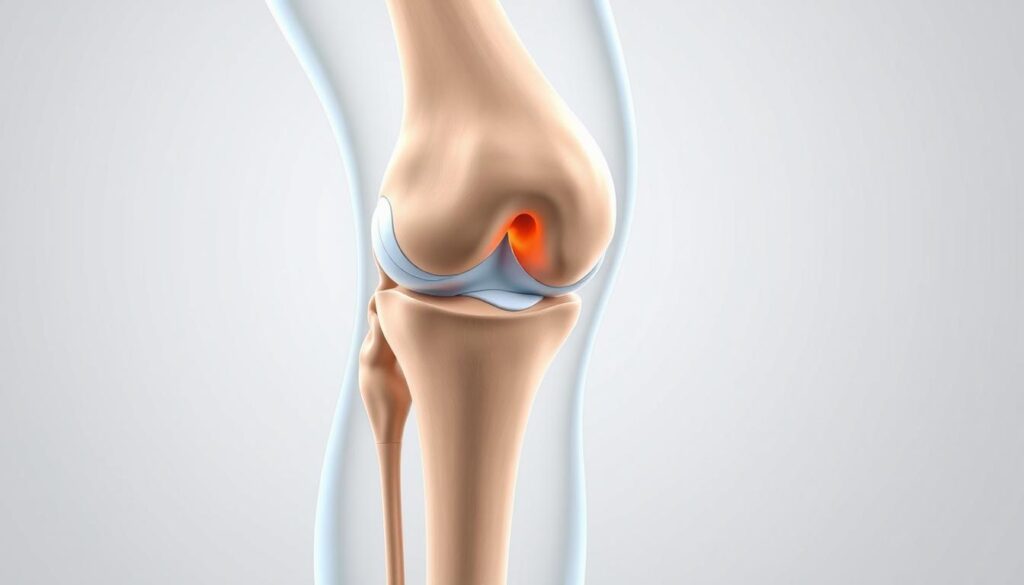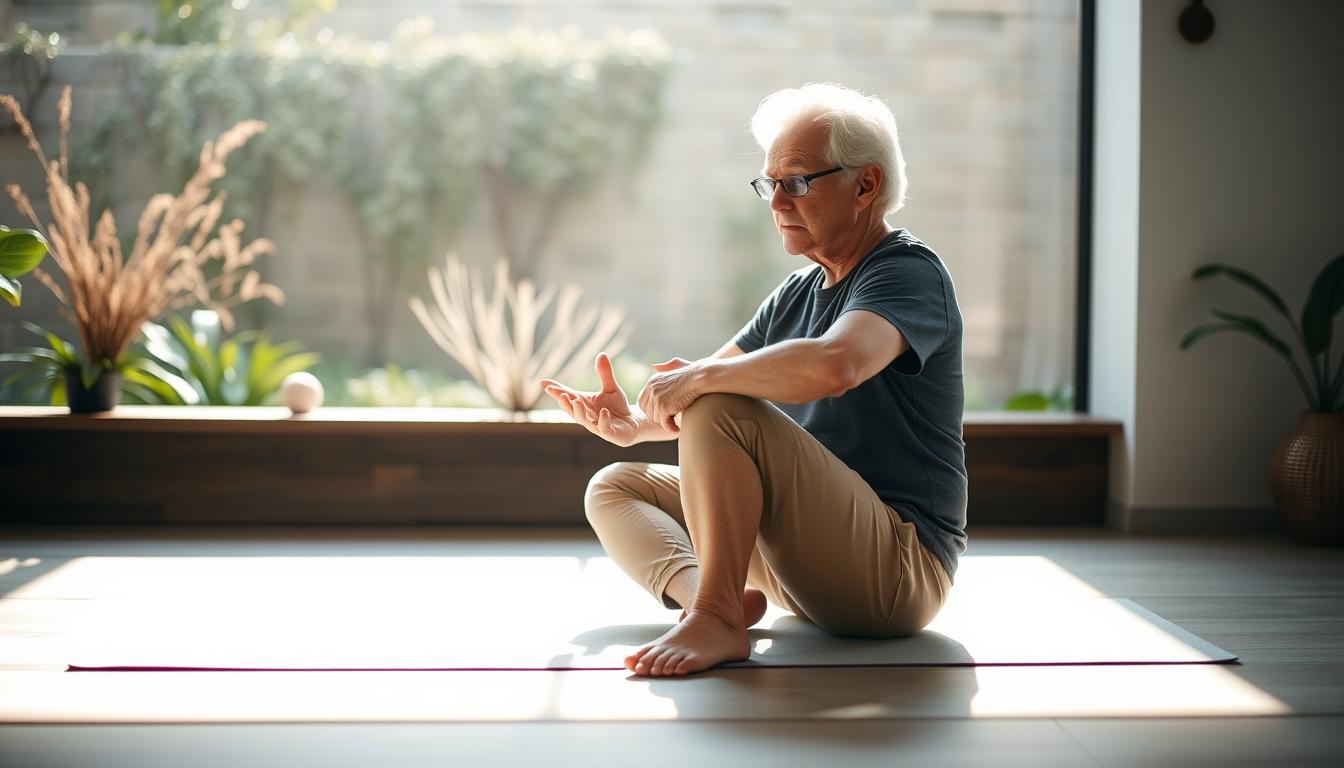What if the key to staying active in your golden years isn’t about pushing harder—but moving smarter? For many older adults, joint discomfort creates a frustrating barrier to fitness. We’ve discovered that strategic, low-impact routines often deliver better results than traditional workouts, especially for improving mobility.
Research from experts like Karen Blum at AARP highlights how tailored movement plans reduce strain while building strength. Take Nancy Volkers, who transformed her daily routine by blending yoga with light cardio. Her story proves that small adjustments can lead to lasting comfort and flexibility.
This guide focuses on sustainable methods backed by physical therapists. You’ll learn how to strengthen supporting muscles, protect cartilage, and avoid common mistakes. Whether you’re gardening or climbing stairs, the right approach makes every motion smoother.
Key Takeaways
- Low-impact workouts minimize stress while improving joint health.
- Combining strength, flexibility, and balance activities yields the best results.
- Personalized routines adapt to individual needs and fitness levels.
- Expert guidance reduces injury risks and enhances progress.
- Consistency matters more than intensity for long-term benefits.
Understanding Knee Pain and Its Causes
Joint discomfort often stems from multiple factors working together. Orthopedic surgeon Dr. Bruce Stewart notes that muscle weakness and poor alignment create a domino effect, stressing vulnerable areas over time. Let’s explore why this happens—and how to break the cycle.

Common Causes and Contributing Factors
Injuries from falls or repetitive motions frequently trigger initial discomfort. Osteoarthritis—a natural wearing down of cartilage—affects 1 in 3 adults over 60. Physical therapist Kari Orlandi explains: “Improper joint position during daily tasks accelerates wear. Think of movement as lubrication—motion is lotion.”
Weak leg muscles fail to absorb shock effectively. This forces joints to compensate, leading to stiffness. Simple fixes like adjusting posture while standing or sitting can redistribute pressure.
Impact of Aging on Joint Health
Muscle mass declines by 3-8% per decade after 30, reducing support for joints. Cartilage also thins naturally, making bones more susceptible to friction. Regular walking maintains circulation, which delivers nutrients to these tissues.
Maintaining proper alignment during activities like climbing stairs protects vulnerable areas. As Dr. Stewart emphasizes: “Strong muscles act like shock absorbers—they’re your first line of defense.” Targeted routines that address root causes offer the most sustainable relief.
Effective Knee Exercises for Seniors
Maintaining joint health requires smart movement strategies that prioritize safety and adaptability. We’ve designed routines focusing on three pillars: strength-building, flexibility enhancement, and injury prevention. These methods work together to create a balanced approach for daily comfort.

Strengthening and Stability Routines
Building leg muscles reduces strain on joints by distributing weight more evenly. The quad set is ideal for beginners: Sit with legs extended, tighten thigh muscles for 5 seconds, then relax. Repeat 10 times. For added support, use a sturdy chair during seated squats—lower halfway, hold 3 seconds, then rise slowly.
Flexibility and Range-of-Motion Movements
Gentle motion maintains joint lubrication and prevents stiffness. Try heel slides: Lie on your back, slide one heel toward hips until a mild stretch occurs. Hold 8 seconds, then return to start. Pair with ankle pumps (pointing toes up/down) to improve circulation.
Home-Based Modifications and Safety Tips
Always position furniture or walls within reach for balance support. Reduce injury risks by avoiding sudden twists and locking joints. Physical therapist Lori Zucker advises: “Focus on controlled movements rather than speed. Quality trumps quantity every time.” Incorporate these routines into daily life—practice while watching TV or waiting for coffee to brew.
Consistent, low-impact activity strengthens legs while managing body weight naturally. This lifestyle adjustment not only supports joints but enhances overall life quality through pain-free movement.
Incorporating a Balanced Knee Health Routine
Building lasting joint health requires more than isolated movements—it demands a holistic strategy. Research from Hinge Health shows that blending different activity types improves stability and reduces discomfort better than single-focus approaches. Dr. Caleb Wolters notes: “Variety prevents overuse injuries while addressing multiple aspects of mobility.”
Integrating Cardio, Resistance, and Balance Workouts
Low-impact cardio like seated marching boosts circulation without strain. Pair this with resistance bands or bodyweight moves—such as wall-assisted squats—to strengthen muscles around joints. A sturdy back chair or wall provides stability during side leg lifts or single-leg stands.
Balance drills matter too. Try shifting weight from heels to toes while holding a counter’s edge. These small challenges build coordination, reducing fall risks. For step-by-step guidance, explore our guide on safe movement patterns tailored for older adults.
Lifestyle Adjustments to Minimize Knee Pain
Daily habits amplify exercise benefits. Anti-inflammatory foods like berries and fatty fish support tissue repair. Staying hydrated keeps cartilage supple—aim for 6-8 glasses daily.
Modify home setups to reduce joint stress. Place frequently used items at waist height to avoid excessive bending. When sitting, use a firm cushion to maintain proper alignment. As Dr. Wolters advises: “Consistency in these tweaks creates compounding benefits over time.”
Real-Life Success Stories and Expert Advice
Transformative results often emerge when professional guidance meets lived experience. We’ve gathered insights from therapists and older adults who’ve reshaped their mobility journeys through simple, sustainable strategies.
Physical Therapy Insights and Expert Recommendations
Physical therapist Kari Orlandi stresses proper form: “Keeping knees bent at safe angles during movements protects joints while building strength.” Her clients use chairs for support during seated marches, maintaining 30-degree bends to reduce strain.
| Focus Area | Expert Tip | Community Tip |
|---|---|---|
| Proper Form | Align hips over ankles during squats | Use mirrors to check posture |
| Consistency | 3x weekly 15-minute sessions | Pair exercises with daily habits |
| Progression | Add resistance bands gradually | Track improvements in a journal |
Community Experiences and Practical Tips
Margaret, 68, regained stair-climbing ability through seated leg extensions. “Starting with knees bent at 90 degrees made all the difference,” she shares. AARP contributors echo this—short daily sessions often outperform intense workouts.
Hinge Health members highlight lifestyle tweaks: placing exercise bands near reading chairs or doing heel slides during TV ads. Dr. Bruce Stewart notes: “Strong muscles don’t just support joints—they unlock fuller participation in life.” These small wins collectively elevate quality of life.
Conclusion
Maintaining mobility as we age hinges on smart choices that prioritize joint care. Strengthening muscles around knee joints and managing body weight transforms daily comfort. Research from Hinge Health shows consistent movement habits reduce arthritis symptoms while boosting balance and strength.
Proper form ensures safety. Always begin from a secure starting position and slowly lower into movements to protect vulnerable areas. This approach builds resilience without strain.
Our program offers exercise help tailored to aging bodies, focusing on progress over intensity. Small adjustments—like using chairs for support—make routines accessible yet effective.
Regular activity preserves independence and enhances well-being. By integrating these strategies, you’ll invest in long-term joint health and a more vibrant lifestyle.

Leave a Reply